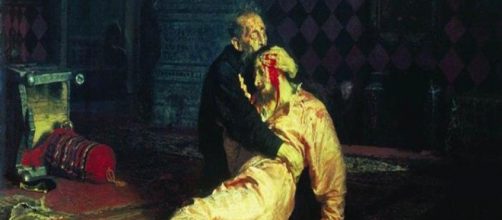Attempts to do harm to pictures on exhibit seem to be less about the pictures and more about the attacker's state of mind. Vandals seem to come with a variety of reasons, from mental illness or personal grievance to the need to make political statements. It's hard to figure out what drove the most recent attack at a State gallery in Moscow. Igor Podporin, a 37-year-old Russian, who tore at one of his country's prized painting -- “Ivan the Terrible Killing his Son” by Ilya Relin -- offered contradictory rationales.
Conscientious objection
At first Podporin said he got drunk on vodka that was served at the show and couldn't hold his liquor because he's not used to that particular spirit.
This suggests, of course, that he wasn't aware of his actions. But later he said that he slashed the painting for “historic reasons.” This is nothing new when it comes to hostility toward this artwork. The feeling is that it makes Ivan look bad. He was Russia's first czar who transformed the country from a medieval state to an empire. “Ivan the Terrible” focuses on the murderous temper that drove him to kill the heir to his throne.
Conspiracy theory
So there are those in Russia now longing for the days of empire-building, who seek to re-write history by saying that Ivan the Terrible wasn't terrible at all. Putin is in this group, telling the press last year that the czar never killed anybody and that his bad reputation is the result of a smear campaign waged by the Catholic Church because he wouldn't convert.
This is probably what the vandal meant when he cited “historical reasons” for his actions. And if you're trying to clean up the image of a madman, you'd want to get such an image out of the public eye. Which is why, five years ago, a group of monarchists sought to get the painting taken down from exhibit walls by complaining to the culture ministry that it was offensive.
Clearly, if you're a proud Russian, you don't want to see your idol spilling blood, especially that of his own child.
Second look
To reconstitute Ivan's reputation, in 2016, a monument to him was erected in a town that he founded. At the dedication, the mayor pooh-poohed history's view of him as a “psychological deviant.” This denial of reality has a familiar ring to it, don't you think?
Dismissing criticisms of a leader as a conspiracy and suggesting that history books have him wrong is not unlike Trump tagging judgments of him “fake news.” But are these monarchists seeing the object of disaffection with jaundiced eyes? If they looked closer at the painting they would see that Ilya Relin put Ivan in a sympathetic light. They would see that as he cradles his dying son, his face is wracked with remorse and self-reproach.


